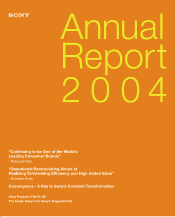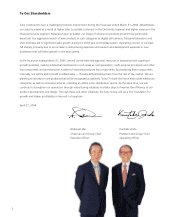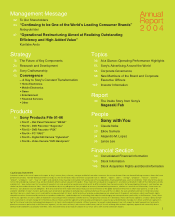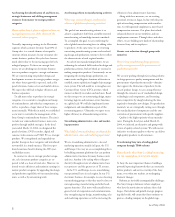Sony 2004 Annual Report Download - page 8
Download and view the complete annual report
Please find page 8 of the 2004 Sony annual report below. You can navigate through the pages in the report by either clicking on the pages listed below, or by using the keyword search tool below to find specific information within the annual report.66
How did Sony perform in the fiscal year
ended March 31, 2004 vis-à-vis its mid-term
corporate strategy TR60?
Sales for the fiscal year ended March 31,
2004 increased 0.3% to ¥7,496.4 billion. Due
to restructuring expenses, operating income
fell 46.7% to ¥98.9 billion.
In the Electronics segment, we focused on
strengthening our product lineup. Sales of flat
panel televisions increased significantly. We
expanded our LCD and plasma television
product lineups, and Grand Wega, our rear-
projection television achieved substantially
higher sales, especially in the U.S. We intro-
duced several new DVD recorder models,
which led to an increase in our market share
from late 2003 to the spring of 2004. In the
intensively price competitive digital still camera
market, the success of our best selling
product, contributed to profitability. We also
retained our leading market share in the video
camera market, which remains the most
profitable category in the Electronics seg-
ment. In the PC market, another area of fierce
competition, we significantly increased profit-
ability in our VAIO business by focusing on
value-added models.
In the Game segment, total cumulative
production shipments of the PlayStation 2
(PS2) consoles surpassed 70 million units.
Software remained strong, too, as the annual
number of units shipped increased, proving
that the PS2 business is still in its peak years. In
the Music segment, past restructuring initia-
tives have resulted in significant improvements
in profitability, allowing us to record an oper-
ating profit, compared with an operating loss
in the previous year, despite the continued
contraction of the global music industry. The
Pictures segment achieved record-breaking
revenues on a U.S. dollar basis due to higher
sales within the television business. In the
Financial Services segment, higher insurance
revenues, along with an improvement in
valuation gains and losses from investments,
contributed to an increase in both revenue
and profit. In April 2004, we established Sony
Financial Holdings Inc. (SFH). This financial
holding company will play a pivotal role in our
drive to create synergies among our life insur-
ance, non-life insurance and banking busi-
nesses, and to increase the total value of our
financial services business.
What are Sony’s primary objectives for the
fiscal year ending March 31, 2005?
I view the current fiscal year as a time for Sony
to firmly execute the fundamental strategies
that were formulated in the previous fiscal year.
In the Electronics and Game segments, we
will accelerate our convergence strategy and
one of the goals is to introduce highly attrac-
tive products in both the home and mobile
electronics categories. In the home electronics
category, we intend to accomplish this by
aggressively pursuing superior display picture
quality and increasing the speed and capacity
of storage devices. We will introduce a rear-
projection television with a high resolution
display device and a home server with more
than a terabyte of storage capacity. In the
mobile electronics category, through close
cooperation with Sony Ericsson Mobile
Communications AB, we will promote the
convergence of our electronics products and
wireless technologies in products such as
cellular phones and wireless LANs. New
mobile products in the pipeline include
PlayStation Portable (PSP), a handheld video
game system, and a cellular phone equipped
with FeliCa, a contactless IC card technology.
We will also continue to invest strategically in
key components such as semiconductors.
Examples of ongoing development projects
include the Cell, a next generation multi
purpose microprocessor; imaging devices like
CCDs and CMOS image sensors; display
devices; and storage devices.
As for our entertainment business, our
entertainment and electronics businesses
joined forces in May 2004 to launch a music
download service called Connect in the U.S.,
and to introduce new Sony products compat-
ible with this service. We will see more con-
vergence between our entertainment and
electronics businesses. At the same time, we
will continue to strengthen our capabilities in
content development and develop new busi-
ness models for the coming network era.
I firmly believe that Sony will remain a
leading consumer brand in the 21st century.
Sony will continue to be a company that
evokes fascination and excitement among its
shareholders and investors, as well as among
its customers, employees and other stake-
holders. The management team is dedicated
to building a new foundation that will sup-
port expansive growth in the years ahead.
While continuing to be a company that evokes
fascination and excitement, the management
team is working together to build a foundation
for future growth





















